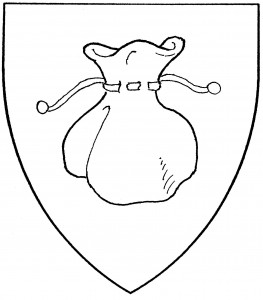A bag is a cloth or leather container that can be tied shut at the top, used for holding money or other small items. The most common form in Society heraldry may also be blazoned a “drawstring bag”, “sack”, or “pouch”; it is a period charge, found in the canting arms of von Sax, 1413 [Conz.Const. clxx], and of von Montsax, 1605 [Siebmacher 202]. (The prefix “string-” helps differentiate these from the basic “(wool-)bag” or “(pilgrim’s) purse” of mundane heraldry.) The bag is typically drawn filled, as in the illustration; and this is sometimes made explicit in blazon, e.g., “money-bag”.
The Society has a few examples of special-purpose bags, usually identified through context: e.g., a “bag with a harp issuant” may be assumed to be a harp-bag, a protective covering for the harp.
The term “bag” was also used in medieval blazon to denote a bundle of goods sold in commerce; for clarity’s sake, in Society blazon, the contents of the bag are explicitly blazoned, as with the bag of madder. For related charges, see scrip.
The Order of the Winged Pouch, of Insula Draconis, bears: A pouch azure winged Or.
Fabiano Figlio degli Due Sacchi bears: Per pale embattled Or and gules, two sacks, their necks tied with cords, counterchanged.
Anton von Heidelberg bears: Lozengy vert and Or, in pale an owl argent perched atop a drawstring pouch fesswise gules.
Renna of Battersea bears as a badge: A lion-posted harp fesswise reversed argent issuant from a bag erminois, lined vert. [Harp-bag]
